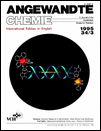Complexes from Polyazacyclophanes, Fluorescence Indicators, and Metal Cations—An Example of Allosterism through Ring Contraction†
Supramolecular Chemistry, Part 51. This work was supported by the Deutsche Forschungsgemeinschaft and the Fonds der Chemischen Industrie. We would like to thank the referees for their valuable suggestions regarding references. Part 50: H.-J. Schneider, M. Wang, J. Org. Chem. 1994, 59, 7473.
Graphical Abstract
A cavity can be made to fit an aromatic guest molecule in certain polyazacyclophanes by contraction of the inner volume, which is initiated by the binding of metal cations. The anticipated cooperative effects can be quantified by fluorescene spectroscopy with suitable indicators, which opens new possibilities for the detection of, for instance, zinc ions in aqueous solution. The ternary complex formed from ligand, metal ion M, and guest G is depicted on the right.





